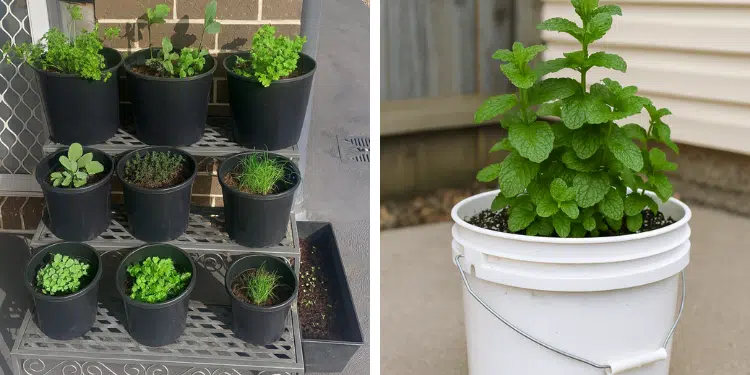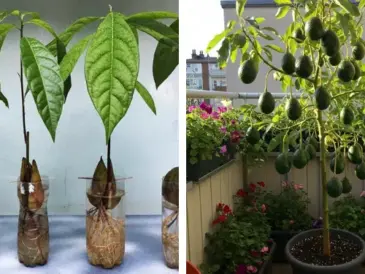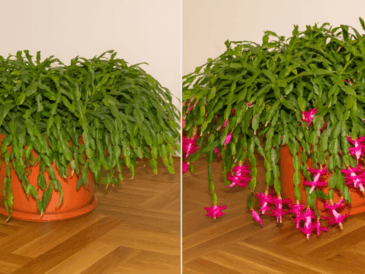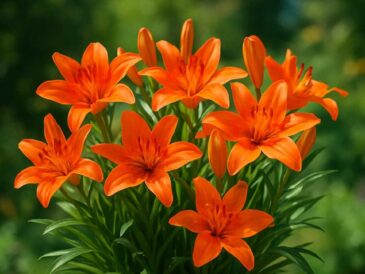As the temperatures drop and most of the garden begins to fade, it’s easy to assume that fresh herbs are off the table until spring.
But the truth is – November is the perfect time to grow herbs in buckets and containers, both indoors and outdoors.
With a little planning and protection from frost, you can harvest fragrant herbs all winter long for cooking, tea, and natural remedies.
Why Buckets Are Perfect for Growing Herbs in November
Before we dive into specific herbs, let’s talk about why buckets are so practical for cold-weather gardening:
- Portability: You can easily move buckets indoors when frost threatens.
- Drainage control: Adding holes to the bottom ensures healthy root systems and prevents rot.
- Space-saving: Buckets fit on balconies, patios, or kitchen corners.
- Warmth retention: The soil inside buckets warms faster during sunny days, keeping roots active.
- Protection from pests: Elevated containers deter slugs and other cold-season pests.
Using 3–5 gallon buckets (with drainage holes) is ideal for most herbs. Fill them with a quality potting mix enriched with compost or worm castings for strong growth.
Best Herbs to Grow in Buckets This November
Even as winter approaches, many hardy or semi-hardy herbs can thrive in containers. Some can stay outdoors with light protection, while others prefer an indoor windowsill with bright light.
Let’s explore the top choices.
1. Parsley (Petroselinum crispum)
Parsley is one of the easiest herbs to grow in cool weather and performs beautifully in buckets. It tolerates light frost and actually improves in flavor during chilly days.
Growing Tips:
- Use a 12-inch-deep bucket with rich, moist soil.
- Place in partial sun or a bright indoor window.
- Keep the soil evenly moist – never let it dry out completely.
Harvest Tip: Cut from the outer stems first, allowing new leaves to grow from the center for continuous harvests.
Bonus: Rich in vitamins A, C, and K – parsley is a powerful immune booster during the winter months.
2. Chives (Allium schoenoprasum)
Chives are extremely hardy and can survive through frost if grown in containers. Their mild onion flavor adds a burst of freshness to soups, omelets, and salads.
Growing Tips:
- Plant in a 10-inch-deep bucket with well-draining soil.
- Keep in a sunny spot – a south-facing window is ideal.
- Cut them down occasionally to encourage fresh growth.
Overwintering Trick: If outdoor temperatures drop below freezing, move the bucket indoors to a cool, bright space – chives will regrow once warmed up.
3. Thyme (Thymus vulgaris)
Thyme thrives in cool, dry conditions and loves being grown in containers. Its low-maintenance nature makes it perfect for busy gardeners.
Growing Tips:
- Use a 10–12-inch bucket with sandy, well-draining soil.
- Allow the top inch of soil to dry between waterings.
- Provide at least 5 hours of sunlight per day.
Bonus: Thyme’s evergreen leaves can be harvested year-round and are known for their antibacterial and respiratory benefits – great for cold season teas.
4. Mint (Mentha spp.)
Mint loves cool weather and grows vigorously in buckets – which is actually the best way to grow it since it can spread aggressively in the ground.
Growing Tips:
- Use a 12–14-inch bucket (mint roots spread fast).
- Keep soil moist but not soggy.
- Place in bright indirect light or morning sun.
Harvest Tip: Pinch back the tips often to encourage bushy, dense growth.
Bonus: Use fresh mint leaves in tea, desserts, or to relieve congestion naturally during cold season.
5. Rosemary (Salvia rosmarinus)
Rosemary is semi-hardy and thrives in buckets as long as it gets enough sunlight. Its aromatic, evergreen leaves provide flavor and natural fragrance through winter.
Growing Tips:
- Use a 12-inch bucket with sandy, well-draining soil.
- Avoid overwatering – rosemary dislikes wet roots.
- Place it near a south-facing window for full sunlight.
Overwintering Tip: If temperatures drop below freezing, bring rosemary indoors. It can overwinter near a window or under grow lights until spring.
6. Cilantro (Coriandrum sativum)
Cilantro prefers cooler weather and often bolts in summer heat – which makes November the perfect time to grow it in buckets.
Growing Tips:
- Use a deep bucket (12 inches) to allow taproot development.
- Sow seeds directly into the soil.
- Keep the bucket in full sun, but protect from harsh winds.
Bonus: Cilantro can tolerate mild frost, and its flavor becomes more intense in cooler temperatures.
7. Oregano (Origanum vulgare)
Oregano is a Mediterranean herb that does well in containers with well-drained soil. It’s evergreen in mild climates and easy to overwinter indoors.
Growing Tips:
- Use a 10-inch bucket with sandy soil.
- Water sparingly; oregano prefers drier conditions.
- Trim regularly to keep it compact.
Bonus: Fresh oregano leaves are rich in antioxidants and natural oils that help fight respiratory infections.
8. Sage (Salvia officinalis)
Sage loves the cool weather of late fall and early winter, making it a perfect choice for November planting. Its gray-green leaves stay beautiful even as other herbs fade.
Growing Tips:
- Use a 12-inch bucket with gritty, well-drained soil.
- Give it full sun for best flavor.
- Water when the top inch of soil feels dry.
Bonus: Sage has powerful cleansing and antimicrobial properties – and it pairs wonderfully with roasted winter dishes.
9. Dill (Anethum graveolens)
Dill grows quickly and prefers cool temperatures, so fall is a great time to start a small batch in buckets.
Growing Tips:
- Choose a deep bucket (at least 12 inches).
- Plant seeds directly – dill doesn’t like transplanting.
- Keep soil moist and place in full sun.
Bonus: Harvest young fronds for garnishes and tea. Dill seeds can also be saved for next spring’s planting.
10. Lemon Balm (Melissa officinalis)
Lemon balm is a hardy perennial that thrives in buckets even in late autumn. Its refreshing lemon scent makes it a favorite for teas and home remedies.
Growing Tips:
- Use a 10–12-inch bucket with rich, loamy soil.
- Keep in partial sun to avoid leaf scorching indoors.
- Prune regularly to encourage new shoots.
Bonus: Lemon balm tea helps with stress relief, sleep, and digestion – perfect for cozy winter nights.
How to Care for Herbs in Buckets During November
Even though many herbs are resilient, November requires a bit of extra care:
Move buckets as needed:
Keep them in the sunniest spots or move indoors during cold snaps.
Water wisely:
Herbs in buckets dry out faster, but avoid waterlogging. Water only when the top inch feels dry.
Add mulch:
A thin layer of straw, leaves, or coco coir keeps roots warm outdoors.
Harvest gently:
Never remove more than one-third of the plant at once to allow regrowth.
Fertilize lightly:
Use a diluted organic fertilizer or compost tea once a month for continuous growth.
Best Indoor Conditions for Winter Herb Buckets
If you plan to keep your buckets inside through winter, replicate natural growing conditions as closely as possible:
- Light: 6–8 hours of sunlight daily (south-facing window or grow light).
- Temperature: 60–70°F (15–21°C) is ideal.
- Air circulation: Avoid placing buckets near heaters or drafts.
- Rotation: Turn buckets weekly so plants grow evenly toward the light.
Herbs to Avoid Planting in November
Some herbs are too tender for late-season planting unless grown under grow lights or in heated rooms. Avoid starting these outdoors in November:
- Basil (too cold-sensitive)
- Stevia
- Lemongrass
- Thai basil or holy basil (tulsi)
If you love these herbs, keep them as indoor-only plants in warm, bright conditions.
November may feel like the end of the gardening season, but it’s actually the start of your indoor herb garden.




